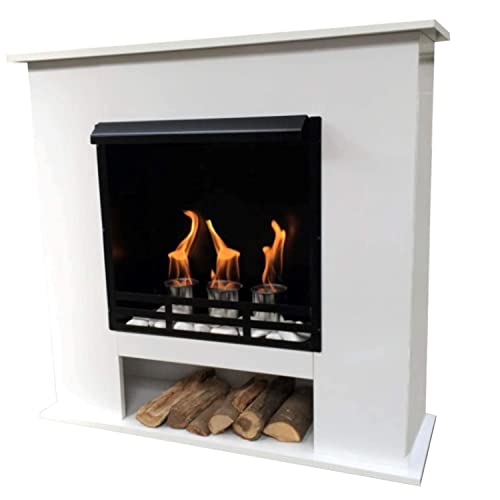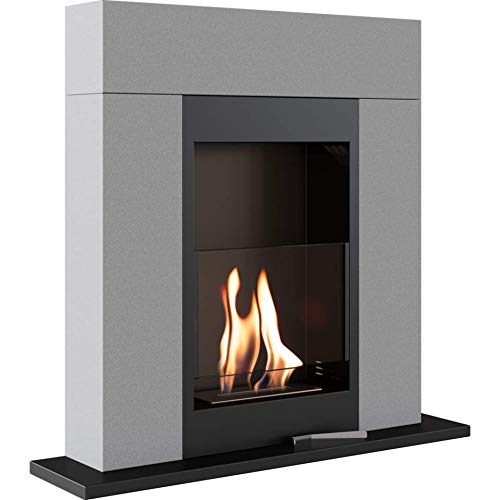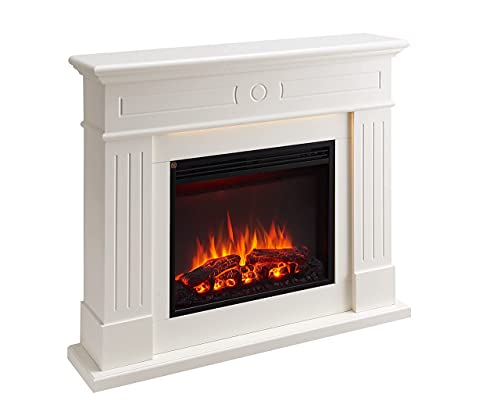A Handbook For Bio Ethanol Fireplace From Start To Finish
Bio Ethanol fireplaces price uk
Ethanol fireplaces are excellent to add a warm feel to any room without the need for expensive structural work or gas supply. They are also the safest kind of fire you can find.
 If you utilize bio-ethanol fuels that have been specifically formulated for your fireplace and adhere to the safety instructions, your Fireplace Price should be safe to operate.
If you utilize bio-ethanol fuels that have been specifically formulated for your fireplace and adhere to the safety instructions, your Fireplace Price should be safe to operate.
Installation is easy
Ethanol fireplaces are a simple and quick solution for homeowners looking to transform their living area or add a focal point to their home decor. There is no need for chimneys and they don't produce dangerous smoke. Soot won't accumulate on your walls or ceilings.
Whether you opt for a full fire suite — such as Mano Mano's Adam Solus Fireplace Suite in Oak with Colorado Bio Ethanol Fire in Black, from PS569 or an independent model that can be moved from room to room (such as the Planika Petit, PS191), installation is simple and doesn't require any expert assistance. All you have to do is make sure that the wall or ceiling is strong enough and follow the instructions for the specific model.
Most fireplaces made of ethanol that are wall-mounted have the hardware necessary to install them as flat screen TVs or recess into the wall. You'll need to locate the studs and fit the brackets and extensions however, it will not take more than one hour for a professional to do so.
There is also the option of manual or automated bioethanol burners. The automatic burner keeps the fuel from the flames so it will burn for longer without the danger of overheating or running out of. Manual burners work exactly the same way as an old-fashioned fireplace, but you'll need matches or lighters to ignite the flames.
It's important to remember when choosing a bio ethanol burner, it must be covered with non-combustible material. This will ensure that nothing touches the burning fuel. If you don't cover your burner properly, it could cause the fire to overheat. This can damage the fireplace.
Ethanol fires are a great option for people who want to create a striking feature in their home, but don't have the money or time to install gas or wood fireplaces. They're the perfect option for new homes or renovations where chimney breasts have been removed. They don't generate ash or soot, so there are no maintenance concerns.
Styles and designs
Bio ethanol fireplaces are available in different styles and designs. Some have a more traditional fireplace design that burns wood, while others are designed to be sleek and modern. Each model has the same benefits, regardless of style: a real flame ambience without harmful gasses or smoke.
Ethanol fireplaces can be freestanding or wall mounted. Freestanding models can be moved around the room to suit your needs. Wall-mounted models are fixed to the walls and require special mounting equipment. They also have to meet certain distances between flammable substances and the unit.
The fire is started through a burner pan, which is located on the bottom of the fireplace. Fuel is poured in this pan and the fire is lit with a long-lasting lighter. It takes around 15 minutes for the flames to reach their full potential. Once the fire is lit you can sit back and relax in your home's warm atmosphere.
Certain ethanol fireplaces come with adjustable heat settings. This allows you to adjust the amount of heat that the fireplace produces.
Another benefit of ethanol fireplaces is that they do not require a chimney or flue. This makes them a great option for older homes or newer ones that don't have chimney fireplaces or traditional fireplaces. In addition, a bio-ethanol fireplace does not produce any toxic gases or ash that could pose a risk for those suffering from respiratory issues.
Bio ethanol fireplaces are also easy to install inside your home. The exact installation time will depend on the type of fireplace you choose. However, the majority of models can be installed quickly. You can also choose an open-air fireplace that you can carry with you in the event of a relocate, making it a great choice to use as a temporary living arrangement. It is essential to consider the ease of installation when purchasing the fireplace.
No flue
The main advantage bio ethanol fires have over traditional wood or gas fires is that they don't require a flue to operate. There is no danger of a chimney fire caused by tar accumulation or a blockage.
Bio-ethanol fireplaces don't create many particles, which could harm the air. This is a great thing for those suffering from allergies or asthma. Another benefit is that there is no smoke generated by the fire and, therefore, it doesn't cause a bad smell in the room.
Bioethanol fireplaces generate a large amount of heat, compared to wood burning fires. This means you can keep your furniture in close proximity to the flame without worrying about catching alight which could be dangerous for your valuables.
There are many designs to choose from for a bio ethanol freestanding fireplace. You can choose a sleek and modern look by installing it on the wall, or you can get one that is recessed to blend into the style of your room.
A burner that is either manual or automated is a different aspect to consider. A manual burner requires you to ignite the fuel directly from the reservoir while an automatic one will automatically light the fire when the tank is empty.
It is crucial to allow the flames to fully burn out and wait until the burner cools down before refilling. If you don't do this, the ethanol might evaporate and you will have to start over.
The majority of manufacturers recommend waiting at least 45 minutes prior to refilling your fire. This gives you enough time to safely remove the flames, and then remove any flammable material from the fire. Additionally, it is recommended to store any spare ethanol fuel somewhere out of reach of children and pets to prevent any accidents from happening.
Easy maintenance
Ethanol fireplaces operate by pouring bio-ethanol fuel into the fireplace and lighting it. The heat and flame created by the burning fuel can be controlled with a slider. (Not all models have this feature). By adjusting the amount of oxygen that is pumped into the fire, you can alter the speed at which the fuel burns, and the intensity of the flame.
As the fuel burns, it produces tiny amounts of soot, which can be easily cleaned by wiping the usa fireplace with a soft cloth. The only other thing to do is to keep the fireplace full of the correct fuel and to ensure it's not in contact with items or materials that are flammable.
Bioethanol fireplaces are easy to set up, and you don't have to be concerned about chimneys or building codes. This allows you to be very flexible when designing your home and where you want to relax in the warmth of your fireplace. You can even opt to have a free-standing model that you can move from room to room.
Wall-mounted bio ethanol fireplaces are able to be fitted into your wall with ease, and some models can be rotated by 180 degrees to direct the flame and heat to the desired space of your room. You can even mount remote controls on some of the designs to take full control from the couch.
Many of the wall-mounted bioethanol fireplaces come with brackets that allow them to be attached to an unfinished ceiling or a sloping one. Installing the fireplace wherever you'd like is possible however, you'll still be able to utilize the remote control to turn off the fireplace and adjust the flame's height as well as set temperature.
When you are not using your ethanol flame ensure that it is off and kept away from any flammable substances or other equipment. Also, don't add fuel to the burner until it's cooled to room temperature. Always be careful when handling the fire as it will be very hot.
Ethanol fireplaces are excellent to add a warm feel to any room without the need for expensive structural work or gas supply. They are also the safest kind of fire you can find.
 If you utilize bio-ethanol fuels that have been specifically formulated for your fireplace and adhere to the safety instructions, your Fireplace Price should be safe to operate.
If you utilize bio-ethanol fuels that have been specifically formulated for your fireplace and adhere to the safety instructions, your Fireplace Price should be safe to operate.Installation is easy
Ethanol fireplaces are a simple and quick solution for homeowners looking to transform their living area or add a focal point to their home decor. There is no need for chimneys and they don't produce dangerous smoke. Soot won't accumulate on your walls or ceilings.
Whether you opt for a full fire suite — such as Mano Mano's Adam Solus Fireplace Suite in Oak with Colorado Bio Ethanol Fire in Black, from PS569 or an independent model that can be moved from room to room (such as the Planika Petit, PS191), installation is simple and doesn't require any expert assistance. All you have to do is make sure that the wall or ceiling is strong enough and follow the instructions for the specific model.
Most fireplaces made of ethanol that are wall-mounted have the hardware necessary to install them as flat screen TVs or recess into the wall. You'll need to locate the studs and fit the brackets and extensions however, it will not take more than one hour for a professional to do so.
There is also the option of manual or automated bioethanol burners. The automatic burner keeps the fuel from the flames so it will burn for longer without the danger of overheating or running out of. Manual burners work exactly the same way as an old-fashioned fireplace, but you'll need matches or lighters to ignite the flames.
It's important to remember when choosing a bio ethanol burner, it must be covered with non-combustible material. This will ensure that nothing touches the burning fuel. If you don't cover your burner properly, it could cause the fire to overheat. This can damage the fireplace.
Ethanol fires are a great option for people who want to create a striking feature in their home, but don't have the money or time to install gas or wood fireplaces. They're the perfect option for new homes or renovations where chimney breasts have been removed. They don't generate ash or soot, so there are no maintenance concerns.
Styles and designs
Bio ethanol fireplaces are available in different styles and designs. Some have a more traditional fireplace design that burns wood, while others are designed to be sleek and modern. Each model has the same benefits, regardless of style: a real flame ambience without harmful gasses or smoke.
Ethanol fireplaces can be freestanding or wall mounted. Freestanding models can be moved around the room to suit your needs. Wall-mounted models are fixed to the walls and require special mounting equipment. They also have to meet certain distances between flammable substances and the unit.
The fire is started through a burner pan, which is located on the bottom of the fireplace. Fuel is poured in this pan and the fire is lit with a long-lasting lighter. It takes around 15 minutes for the flames to reach their full potential. Once the fire is lit you can sit back and relax in your home's warm atmosphere.
Certain ethanol fireplaces come with adjustable heat settings. This allows you to adjust the amount of heat that the fireplace produces.
Another benefit of ethanol fireplaces is that they do not require a chimney or flue. This makes them a great option for older homes or newer ones that don't have chimney fireplaces or traditional fireplaces. In addition, a bio-ethanol fireplace does not produce any toxic gases or ash that could pose a risk for those suffering from respiratory issues.
Bio ethanol fireplaces are also easy to install inside your home. The exact installation time will depend on the type of fireplace you choose. However, the majority of models can be installed quickly. You can also choose an open-air fireplace that you can carry with you in the event of a relocate, making it a great choice to use as a temporary living arrangement. It is essential to consider the ease of installation when purchasing the fireplace.
No flue
The main advantage bio ethanol fires have over traditional wood or gas fires is that they don't require a flue to operate. There is no danger of a chimney fire caused by tar accumulation or a blockage.
Bio-ethanol fireplaces don't create many particles, which could harm the air. This is a great thing for those suffering from allergies or asthma. Another benefit is that there is no smoke generated by the fire and, therefore, it doesn't cause a bad smell in the room.
Bioethanol fireplaces generate a large amount of heat, compared to wood burning fires. This means you can keep your furniture in close proximity to the flame without worrying about catching alight which could be dangerous for your valuables.
There are many designs to choose from for a bio ethanol freestanding fireplace. You can choose a sleek and modern look by installing it on the wall, or you can get one that is recessed to blend into the style of your room.
A burner that is either manual or automated is a different aspect to consider. A manual burner requires you to ignite the fuel directly from the reservoir while an automatic one will automatically light the fire when the tank is empty.
It is crucial to allow the flames to fully burn out and wait until the burner cools down before refilling. If you don't do this, the ethanol might evaporate and you will have to start over.
The majority of manufacturers recommend waiting at least 45 minutes prior to refilling your fire. This gives you enough time to safely remove the flames, and then remove any flammable material from the fire. Additionally, it is recommended to store any spare ethanol fuel somewhere out of reach of children and pets to prevent any accidents from happening.
Easy maintenance
Ethanol fireplaces operate by pouring bio-ethanol fuel into the fireplace and lighting it. The heat and flame created by the burning fuel can be controlled with a slider. (Not all models have this feature). By adjusting the amount of oxygen that is pumped into the fire, you can alter the speed at which the fuel burns, and the intensity of the flame.
As the fuel burns, it produces tiny amounts of soot, which can be easily cleaned by wiping the usa fireplace with a soft cloth. The only other thing to do is to keep the fireplace full of the correct fuel and to ensure it's not in contact with items or materials that are flammable.
Bioethanol fireplaces are easy to set up, and you don't have to be concerned about chimneys or building codes. This allows you to be very flexible when designing your home and where you want to relax in the warmth of your fireplace. You can even opt to have a free-standing model that you can move from room to room.
Wall-mounted bio ethanol fireplaces are able to be fitted into your wall with ease, and some models can be rotated by 180 degrees to direct the flame and heat to the desired space of your room. You can even mount remote controls on some of the designs to take full control from the couch.
Many of the wall-mounted bioethanol fireplaces come with brackets that allow them to be attached to an unfinished ceiling or a sloping one. Installing the fireplace wherever you'd like is possible however, you'll still be able to utilize the remote control to turn off the fireplace and adjust the flame's height as well as set temperature.
When you are not using your ethanol flame ensure that it is off and kept away from any flammable substances or other equipment. Also, don't add fuel to the burner until it's cooled to room temperature. Always be careful when handling the fire as it will be very hot.

 How to Get the Most From a Wood Burner Fireplace
How to Get the Most From a Wood Burner Fireplace